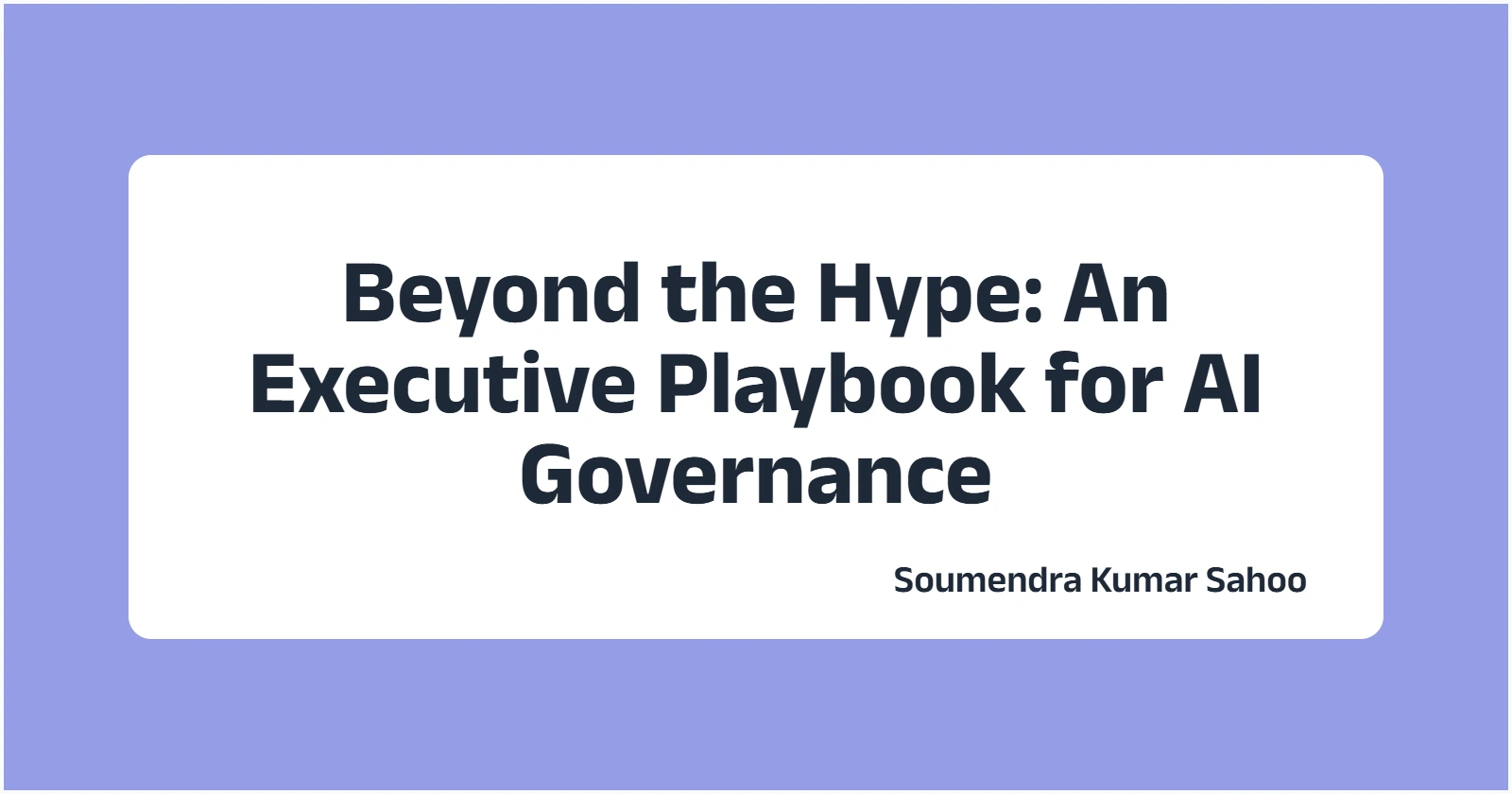Beyond the Hype: An Executive Playbook for AI Governance (2025 Edition)
A practical, case‑driven guide for CXOs and engineering leaders to build trustworthy, compliant and revenue‑generating AI systems. TL;DR — Good AI governance accelerates revenue, de‑risks regulatory exposure and earns stakeholder trust. This playbook delivers a six‑pillar governance framework, real‑world wins and missteps, and an executive‑friendly 90‑day action plan. Global spending on enterprise AI is forecast to reach $297 billion by 2027[1]. Yet only 35 % of C‑suite leaders say they can fully explain their AI models to stakeholders[2]. Recent headlines show the cost of blind spots: Governance is no longer a “nice to have”; it is business continuity. AI governance is the operating system that aligns models with corporate strategy, ethics and regulation—from ideation to retirement. A resilient program unifies six pillars: “Move fast and break things” breaks differently when a model writes credit limits or medical orders. Fin‑tech with a large‑language‑model chatbot launches without red‑teaming; within 48 hours it produces defamatory financial advice, prompting an SEC probe. Healthcare provider’s sepsis model silently degrades; ICU teams disable alerts after false negatives rise 200 %. Regulators cite “algorithmic negligence.”[5] Prioritize first: model registry, risk taxonomy, and real‑time monitoring. Defer: advanced fairness tooling until critical models are stable. Findings align with the 2024 Responsible AI Benchmark, where 72 % of organizations budget <$500k for initial governance rollout[7]. Include pre‑baked comms templates for a 5‑slide board deck and a 2‑minute all‑hands update. Cultural shift tip: celebrate “bias bugs” the same way you celebrate security vulnerabilities — public kudos beats private blame[2]. Refer to ISO/IEC 23053 for lifecycle definitions[9] and ISO/IEC 42001 for management‑system alignment[10]. McKinsey finds orgs that mature AI governance capture 20‑40 % more value from their models[11]. AI’s upside is undeniable—but only if executives treat governance as a revenue enabler, not red tape. Start with the 90‑day plan above, measure everything, and iterate. https://www.cdomagazine.tech/aiml/global-ai-spending-to-reach-297-billion-by-2027-read-full-report ↩ https://www.ibm.com/thought-leadership/institute-business-value/en-us/report/ai-governance ↩ ↩2 https://www.michigan.gov/difs/news-and-outreach/press-releases/2025/01/15/michigan-joins-80-million-enforcement-action-against-block-inc-cash-app-for-violations ↩ https://jamanetwork.com/journals/jamainternalmedicine/fullarticle/2781307 ↩ ↩2 https://www.mckinsey.com/capabilities/growth-marketing-and-sales/solutions/periscope/resources/impact-stories/mediamarkt-masters-personalization-experience-delivery-at-scale ↩ https://www.modelop.com/resources-ebooks/responsible-ai-report-2024 ↩ https://www2.deloitte.com/dl/en/pages/legal/articles/contracting-generative-ki-risikominderung-lieferkette.html ↩ https://aws.amazon.com/blogs/security/ai-lifecycle-risk-management-iso-iec-420012023-for-ai-governance/ ↩ https://www.mckinsey.com/~/media/mckinsey/business%20functions/quantumblack/our%20insights/the%20state%20of%20ai/2025/the-state-of-ai-how-organizations-are-rewiring-to-capture-value_final.pdf ↩ https://www.reuters.com/legal/legalindustry/ai-focused-procurement-playbook-refresh-2024-04-10/ ↩
1 Why Governance Is Now Board‑Level Business
2 What Exactly Is AI Governance?
Pillar Purpose Typical Artifacts Policy & Standards Define guardrails Ethical charter, coding standards Risk Management Identify & triage risks Model‑risk taxonomy, impact assessments Transparency Make models explainable Data lineage, model cards Accountability Clarify ownership RACI matrix, audit logs Monitoring & Evaluation Detect drift & bias early KPI dashboards, fairness tests Continuous Improvement Learn & iterate Post‑mortems, lessons‑learned library 3 Regulatory Landscape 2025
Region Key Rule What Matters EU AI Act Fines up to 7 % of turnover; high‑risk use‑case registry India DPDP Act 2023 Consent‑driven data use, algorithmic transparency US NIST AI RMF Voluntary today; de‑facto gatekeeper for federal contracts 4 The Cost of No Governance
5 Success Stories (It’s Not All Doom)
6 90‑Day Implementation & Resource Blueprint
Phase Goal Typical Budget Critical Roles Days 0‑30 Baseline & gap analysis $25‑75 k (SMB) Governance lead, ML engineer Days 31‑60 Policy draft + monitoring POC $75‑250 k (mid‑market) Compliance counsel, SRE Days 61‑90 Full rollout & training $250 k‑1 M (enterprise) Risk officer, SecOps 7 Stakeholder‑Engagement Framework‑Engagement Framework
Stakeholder What They Care About Engagement Tactic Board Reputation, fines Quarterly “AI risk heat‑map” memo Engineering Velocity, tooling overhead DevEx‑friendly policy checklists Product & Sales Time‑to‑market “Governance guardrails = faster launches” roadshow Customers Trust, reliability Plain‑language FAQs & transparency reports 8 Vendor & Third‑Party Risk Management & Third‑Party Risk Management
9 Industry‑Specific Quick‑Checks‑Specific Quick‑Checks
Sector Key Extra Risks Must‑Have Controls Healthcare Diagnosis bias, FDA compliance Model card + real‑time drift alarms Financial Services Fair lending, AML Explainability reports + adversarial testing Retail Dynamic pricing fairness Segmented bias metrics 10 Technical Implementation Essentials Implementation Essentials
11 Measurement & ROI Framework & ROI Framework
KPI Target Why It Matters Time‑to‑deploy (days) ↓ 50 % Governance automation accelerates launches Incident MTTR (hrs) < 4 hrs Faster recovery → less loss Revenue at risk per incident – 30 % Demonstrates cost‑avoidance 12 Emerging Risks & Trends (2025‑27) Risks & Trends (2025‑27)
13 Crisis‑Management Playbook‑Management Playbook
14 Conclusion
References